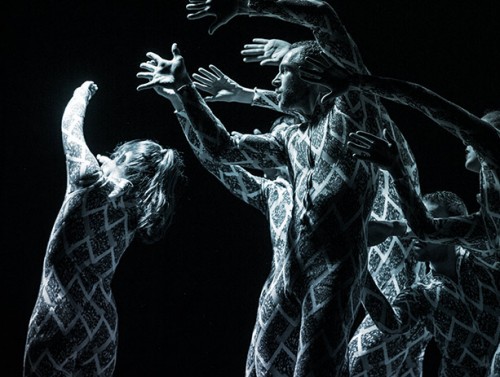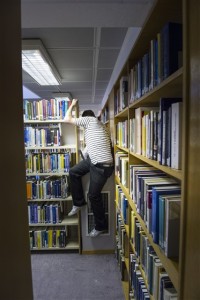By Robert P Crease
I’m fascinated by the interactions between science and culture, which is what led me to the Brooklyn Academy of Music (BAM), which was hosting the US première of a dance piece called Quantum that had previously debuted where it had been created, at CERN. The event was staged in a simple, black-box space, with the audience seated around a square floor in three rows with no proscenium. But it was an upscale black box, with elegant seating upholstered in a blue-and-gold metallic sheen. Four industrial lights were suspended from the ceiling by long cables.
The lights dimmed. When they came back on, six dancers paired in couples jiggled and jerked as if buffeted by Brownian-like forces. The overhead lights began moving in slow, silent circles, making it seem as if the stage itself were in motion. Symmetries appeared in some movements of the dancers, passing from couple to couple, while the music alternately crackled, chimed and sounded like static. The dancers ceased their pairings and began moving as a plasma-like whole. At one point they gathered together to create a sphere with their hands; their movements were shaping an object whose movements began shaping their own. The four overhead lights now began to move independently, making light splotches combine and recombine all over the dancers and floor – and it suddenly dawned on me that this kinetic lighting system, too, was part of the performance. (I hadn’t read the programme carefully beforehand.) The motions of dancers and lights eventually slowed to a halt. The light vanished, once again bathing the black box in darkness. The ensemble of wavelike movements of the particle-like dancers, I thought, had created an artistic whole.
André Schaller, Switzerland’s Ambassador and Consul General in New York, opened the reception afterwards by citing the piece as the product of a “creative collision” between art and science.
I ran into Gilles Jobin, who had choreographed Quantum during an artist’s residency at CERN. I asked him the following question: “If a fellow choreographer who knew nothing about the piece were to watch it, is there anything in the movement or structure of the work that might cause that person to say ‘That choreographer must have spent several months at a physics lab!’?” Gilles paused, then said “No.” The influence of the laboratory environment, he said, was in inspiring him to come up with certain kinds of what he called “movement generators”, or inspirations for the dancers to create their own movements. “For instance, all those symmetries – like ghost symmetries – that I didn’t even know existed!” he said. I asked him why he had chosen the work’s title. “I considered other names,” he said. “Basically, Quantum was just a convenient tag that referred to the context – the CERN laboratory environment – in which I had created the work.”
It was easy to pick out Julius von Bismarck, designer of the kinetic lighting system. His appearance – tall, shaved head, long flowing beard – is as unforgettable as his name. He had also been to CERN, and I asked him how, if at all, the laboratory environment had shaped the work. “Interference,” he said. “I thought a lot about the way light interacts with itself to form patterns. Also chaos – the way patterns can turn slowly to chaos but we still seek patterns in the chaos.”
Carla Scaletti, who composed the music, told me that a physicist working on the ATLAS experiment had provided her with some LHC data files, and that she had used the numbers in those files to control the parameters of her sound.
The six dancers in Jobin’s company were from five different countries; they included Catarina Barbosa from Portugal, the shortest dancer. I asked her if she had felt any difference between performing the work at BAM and at CERN. She told me that there definitely was a difference. The CERN performances were on a stage above the CMS detector, and it definitely felt like a “physics space”. At BAM, she said, it was a “dancer’s space”, more intimate.
For symmetry considerations, I thought I’d end the evening by tracking down the tallest dancer, a Brazilian. But by then the power of the quantum was weakening, I lost track of him, and I headed back to Manhattan.


Quite interesting to watch and feel the symmetry and chaos of the mixing and demixing of the dancing and the lighting in the place – a black box ,rythmed by the CERNish music, but all of it was girating around a point, unlike the non-lcal basics of the Quantum world.
An awesome mix of lightning effects,black box,dancers steps…all portrays a perfect quantum effects! So good…lov it!
Trackback: Quantum; an upcoming dance performance in Vancouver, Canada | FrogHeart